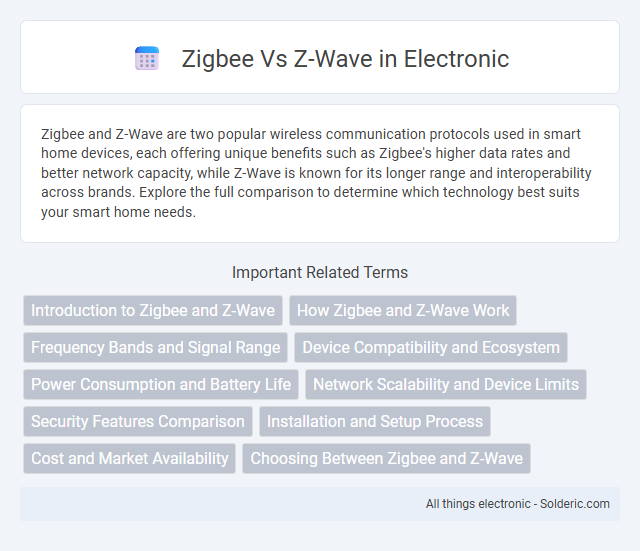Zigbee and Z-Wave are two popular wireless communication protocols used in smart home devices, each offering unique benefits such as Zigbee's higher data rates and better network capacity, while Z-Wave is known for its longer range and interoperability across brands. Explore the full comparison to determine which technology best suits your smart home needs.
Comparison Table
| Feature | Zigbee | Z-Wave |
|---|---|---|
| Frequency | 2.4 GHz (global) | 868 MHz (EU), 908 MHz (US) |
| Range | 10-100 meters (line of sight) | 30-100 meters (line of sight) |
| Data Rate | 250 kbps | 40 kbps (older), 100 kbps (newer) |
| Network Size | Up to 65,000 devices | Up to 232 devices |
| Interoperability | Multiple manufacturers, requires certification | Strong interoperability, certified ecosystem |
| Power Consumption | Low power, suitable for battery devices | Very low power, optimized for battery devices |
| Security | AES-128 encryption | AES-128 encryption with S2 framework |
| Use Cases | Home automation, industrial IoT, smart lighting | Home automation, security systems, smart locks |
| Topology | Mesh network | Mesh network |
| Cost | Generally lower cost modules | Higher cost but stable connection |
Introduction to Zigbee and Z-Wave
Zigbee and Z-Wave are leading wireless communication protocols designed for smart home automation, emphasizing low power consumption and reliable device connectivity. Zigbee operates on the IEEE 802.15.4 standard in the 2.4 GHz frequency band, supporting mesh networking with thousands of devices for extensive interoperability. Z-Wave functions in a sub-GHz frequency band (around 900 MHz), optimizing long-range communication and reduced interference, with a focus on home automation through a managed device ecosystem.
How Zigbee and Z-Wave Work
Zigbee operates on the IEEE 802.15.4 standard using the 2.4 GHz frequency band, enabling devices to form mesh networks that enhance communication reliability and range in smart home systems. Z-Wave functions in the sub-1 GHz spectrum, typically around 908 MHz in the US, utilizing a wireless mesh topology to facilitate low-latency and interference-resistant device communication. Both protocols use mesh networking to extend coverage by routing signals through multiple nodes, but Zigbee's higher frequency allows for faster data rates, while Z-Wave's lower frequency provides better penetration through walls.
Frequency Bands and Signal Range
Zigbee operates primarily on the 2.4 GHz frequency band, offering a global standard with data rates up to 250 kbps but typically has a shorter signal range of about 10-20 meters indoors. Z-Wave functions on lower frequency bands, such as 908.42 MHz in the US and 868.42 MHz in Europe, which reduces interference and extends its signal range up to 30-100 meters indoors. Your choice between Zigbee and Z-Wave will impact network reliability and device compatibility based on the frequency band and signal range suited to your smart home environment.
Device Compatibility and Ecosystem
Zigbee offers broad device compatibility with thousands of products from various manufacturers, creating a robust ecosystem that supports smart lighting, sensors, and home automation hubs. Z-Wave operates on a more controlled frequency, resulting in a tighter-knit, interoperable ecosystem with over 3,000 certified devices specifically designed for home automation security and convenience. Your choice depends on the desired breadth of device variety versus a more standardized, reliable network within your smart home setup.
Power Consumption and Battery Life
Zigbee typically offers lower power consumption compared to Z-Wave due to its efficient communication protocol and faster data transfer rates, which prolong battery life in compatible devices. Z-Wave devices generally operate at a lower frequency (around 900 MHz), providing better range but slightly higher energy use over extended periods. For battery-powered smart home devices, Zigbee's power efficiency often results in longer battery life, making it preferable for applications requiring minimal maintenance and extended operation.
Network Scalability and Device Limits
Zigbee supports network scalability with the ability to connect up to 65,000 devices, making it ideal for large smart home systems or extensive IoT networks. In contrast, Z-Wave networks typically limit the number of devices to around 232, which may suffice for smaller setups but restrict expansion possibilities. Your choice between Zigbee and Z-Wave should consider future growth needs and the maximum number of supported devices within your smart home ecosystem.
Security Features Comparison
Zigbee and Z-Wave both provide robust security features, with Zigbee using AES-128 encryption and a decentralized mesh network that enhances resilience against attacks. Z-Wave also employs AES-128 encryption but incorporates S2 security framework, offering enhanced key exchange and protection against interception. Your smart home's safety depends on choosing a protocol with strong encryption and secure device pairing, where Z-Wave's S2 framework offers an extra layer of security advantage.
Installation and Setup Process
Zigbee offers a straightforward installation with many devices supporting automatic network discovery and easy pairing through compatible hubs, ideal for users looking for quick setups. Z-Wave requires device inclusion through a primary controller, often involving manual steps like pressing physical buttons, which ensures secure and reliable connections but can be slightly more complex for beginners. Both protocols prioritize interoperability within their ecosystems, but Zigbee's ubiquity in smart home products often results in a wider variety of devices for seamless integration.
Cost and Market Availability
Zigbee devices are generally more cost-effective due to their widespread adoption and large manufacturer base, leading to lower prices and extensive availability in the smart home market. Z-Wave products tend to be pricier, reflecting their specialized chipsets and smaller but dedicated ecosystem, which limits market diversity. Both protocols are supported by numerous brands, but Zigbee's integration with major tech companies enhances its accessibility and variety.
Choosing Between Zigbee and Z-Wave
Choosing between Zigbee and Z-Wave depends on your smart home needs, device compatibility, and network range. Zigbee operates on the 2.4 GHz frequency, offering faster communication and a larger ecosystem of devices, while Z-Wave uses sub-1 GHz frequencies, providing better range and less interference. Your decision should prioritize the available device options and the environment where your smart devices will be installed for optimal performance.
Zigbee vs Z-Wave Infographic

 solderic.com
solderic.com